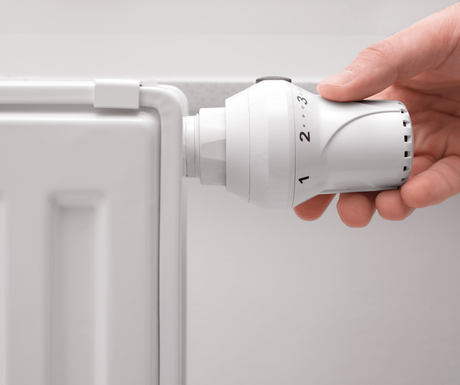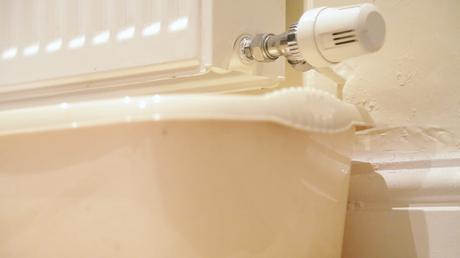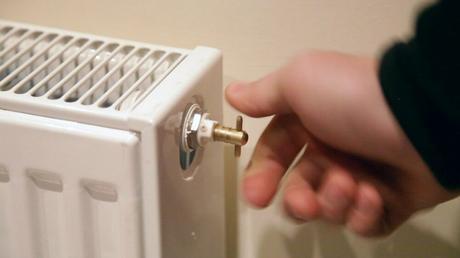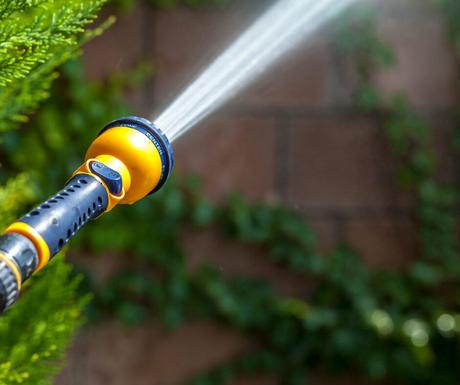Does your radiator feel cold at the bottom? If so, your radiator might be full of sludge that needs flushing out.
Flushing a radiator basically means taking the radiator outside and giving it a good clean by flushing fresh water through it to get rid of any gunk.
If the radiator is cold at the top there could be trapped air inside. So instead of flushing the system you will need to bleed your radiator to release the air.
But if you just want to clean the inside of your radiator to tidy it up and remove any trapped dust, you can find out what to clean it with and how to do it here.
You have two options to remove sludge from your radiator, you could give your plumber a call to power flush the system or get the job done yourself.
Do You Really Need To Flush Your Radiator?Before you start, are you sure that you really need to flush your radiators? If you notice any of the following signs, we would advise flushing your radiator to keep your heating working efficiently:
1. Cold patches at the bottom of the radiator.
2. Brown liquid when you bleed your radiator.
3. Radiators need bleeding often.
4. Boiler makes loud noises.
5. Broken or leaking heat pump.
Radiator sludge is a combination of rust, dirt and scale that inevitably builds up over time and circulates through the system.
If you have blocked radiators and don’t remove the sludge, the build-up will make your heat pump and radiators work harder by preventing the hot water from circulating properly.
This means that heating won’t be working efficiently and could be costing you more money for less heat.
Sludge is also the biggest cause of boiler breakdowns and can rapidly age your system.
But there are a few different ways to deal with it.
So how do you flush out a radiator yourself? Follow these 10 steps and your radiator will be as good as new.
You Will Need:
- Old towels or sheets
- Spanner
- Large bowl or bucket
- Radiator bleed key
- Hose pipe
- Rubber hammer (optional)
How To Flush A Radiator
Time needed: 1 hour and 30 minutes.
- Turn the heating off
Whenever you are doing work on your radiators always remember to turn the heating off and let the radiators cool down before you start. It usally takes about half an hour to let them cool down fully.

- Protect your floors
Cover your floors with old sheets or towels to keep them clean when you’re getting the sludge and dirty water out!
- Turn both valves off
Shut the radiator off from the rest of your central heating system by turning the valves at both ends of the radiator off.
Turn the TRV (thermostatic radiator valve) off by hand by twisting it clockwise or to the ‘0’ position.
To turn the lockshield valve off you will need to remove the plastic cap then use a spanner to turn the valve clockwise all the way.

- Loosen the TRV
Use a spanner to loosen the nut that joins the TRV to the radiator.
- Open the bleed valve
Place a bucket underneath the TRV and use a radiator bleed key to open the bleed valve to remove any air pressure.

- Drain the radiator
Catch any sludge and dirty water that flows out of the valve with your bucket. Then loosen the nut on the lockshield valve with your spanner and catch the water out of that side of the radiator too.
Once you have drained the radiator, close the bleed valve with your bleed key.

- Take the radiator off the wall
Now that you have loosed the nuts on both valves you should be able to remove the radiator with no trouble.
We would advise taking the radiator outside to flush it as it can be a messy job!
The radiator will probably still have some dirty water and sludge inside so make sure to cover the inlets with a towel or plastic bags while you transport it.
- Flush the radiator
Attach the hose pipe to the radiator valve inlet and turn the tap on full blast to give the radiator a good flush. The flow of clean water flushing through the radiator and out of the other inlet should bring all the sludge with it.
If you have a rubber hammer at home, you could use it to give the radiator a tap to try and dislodge the build-up of sludge.
It’s a good idea to hold the radiator over a drain to keep your garden nice and tidy. Repeat this process by attaching the hose to the valve inlet at the other end of the radiator to get as much sludge out as you can until the water runs clear.

- Reconnect your radiator
Hang the radiator back on the wall, re-tighten the nuts and open both valves. Remember to turn the lockshield valve the same number of times as you did when removing the radiator.
Open the bleed valve with your key to allow any trapped air to escape from the air vent.
- Check the boiler pressure
Disconnecting the radiator can cause the boiler pressure to drop so you may need to top it back up. Since the heating is still off, the boiler pressure should be between 1 and 1.5 bar.
If the pressure has dropped below 1 you will need to repressurise the system using the external filling loop.
Now you should be left with a squeaky-clean sludge free radiator. Nice work!
But how do you stop it from coming back?
How to stop radiator sludge building up
Add more inhibitor to the heating system
Inhibitor is a chemical treatment that breaks down any unwanted particles in your heating system. Make sure to keep an eye on the inhibitor levels and top it up if it drops too low.
Install a magnetic filter before your boiler
Magnetic filters are great for collecting rust and other magnetic particles before they settle and block your system again.
These filters are usually installed before your boiler and can be emptied to ensure it continues to catch the sludge efficiently.
You can add a filter to your existing system, or if you are updating your whole heating system ask your plumber about magnetic filters before your new boiler installation.
Power flush your heating system
If you’re still having problems with your radiators and you have tried to flush them out it may be that there is sludge stuck in the pipework.
To get rid of sludge in your pipes you’re going to need more help than a hose pipe! This will require the specialist equipment and chemicals that gas safe engineers have to effectively remove the sludge and debris from the radiators and pipework.
Contact a gas safe registered plumber to power flush your system. This is usually a fixed price and can cost anything from £300 up to £700 depending on how blocked the system is and how many radiators you have.
Get An Annual Service
We often take our boilers for granted and expect them to work brilliantly all the time! But remember to look after your boiler and book an annual service to prevent any small issues becoming big problems.
If your heating system does need a power flush this should be noticed during the service.
We hope this guide has helped you out! If you have any questions, leave a comment and we will get back to you as soon as we can.

